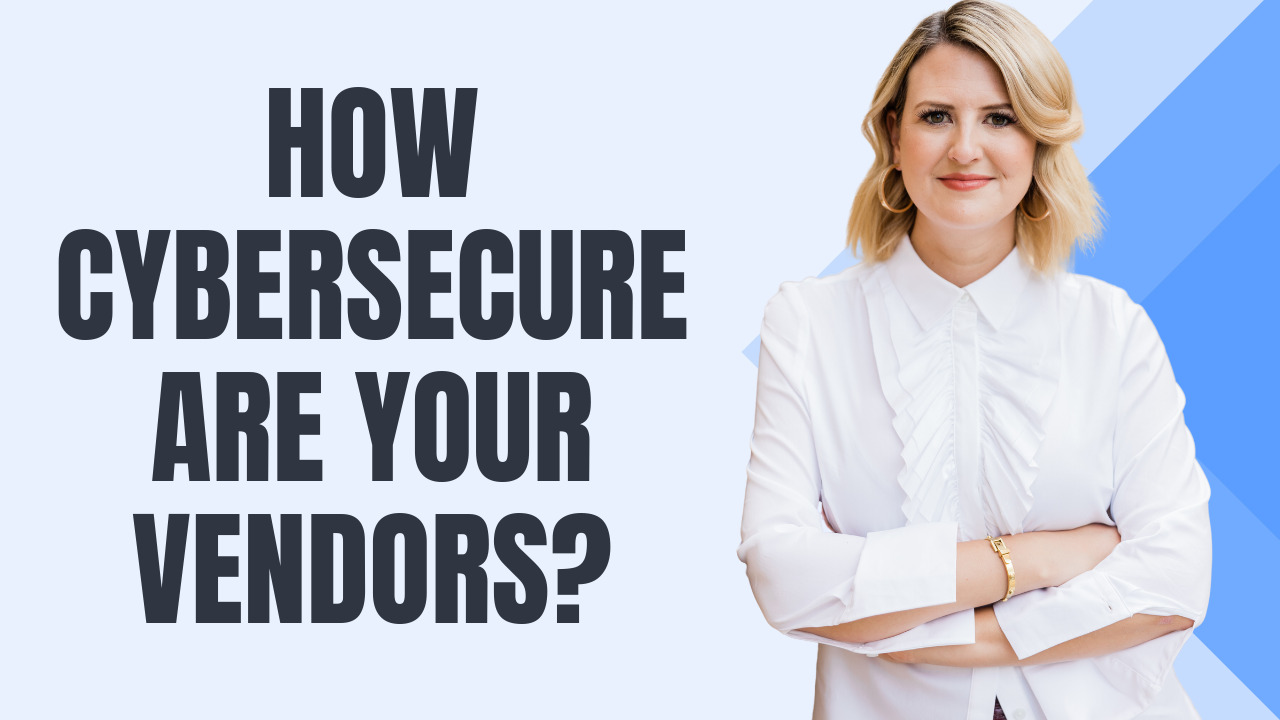How Cybersecure Are Your Vendors And Business Partners? Evaluating Third-Party Risk
In today’s interconnected business world, cybersecurity is as much about protecting your organization as it is about ensuring the security of your vendors and business partners. As companies rely more heavily on third-party providers for services, data storage, and applications, the risk of potential data breaches and cyber-attacks increases. Understanding the importance of vendor and business partner cybersecurity is crucial in developing robust security measures and safeguarding sensitive information.
Assessing the cybersecurity posture of your vendors and business partners involves evaluating their security policies, practices, and overall threat landscape. Identifying potential vulnerabilities and risks in their security measures can provide essential insights into how your organization might be affected. By taking a proactive approach and implementing best practices, companies can effectively mitigate cybersecurity risks and foster strong partnerships built on trust and security.
Key Takeaways
- Cybersecurity practices are crucial for organizations and their vendors and business partners.
- Assessing the cybersecurity posture of vendors and business partners helps identify potential risks.
- Implementing best practices can enhance overall cybersecurity and build strong relationships.
Understanding Vendor and Business Partner Cybersecurity
Defining Vendor Cybersecurity
Vendor cybersecurity refers to the measures and practices employed by third-party organizations, such as suppliers and service providers, to protect their information systems and data. When evaluating a potential vendor’s security posture, you should focus on a few key indicators of performance:
- Compromised systems: These are the systems that represent evidence of successful cyber attacks. Although a compromised system does not necessarily equate to data loss, each indicates vulnerability.
- Security standards: Before onboarding new vendors, set a minimum acceptable risk threshold that a third party must achieve to be considered a partner. Use a security rating to establish a consistent and uniform way to assess their cybersecurity performance.

Defining Business Partner Cybersecurity
Business partner cybersecurity is the set of practices and measures organizations enforce in collaborations, joint ventures, and partnerships with other companies to protect their shared information assets. Ensuring secure business relationships involves actively managing and monitoring the cybersecurity risks associated with these connections. Here are some steps to take:
- Holistic risk assessment: Analyze procurement data for different aspects of your company’s business to identify areas of potential risk exposure. Collaborate with your legal department to determine the scope of third-party contractual relationships.
- Vendor risk management: Recognize that your third parties can be exposed to significant risk from their vendors. Implement a comprehensive approach to assess and mitigate these risks throughout your collaboration.
By staying informed about the cybersecurity measures and performance of your vendors and business partners, you can proactively protect your organization from potential cyber threats in a connected world.
Assessing Vendor and Business Partner Cybersecurity
Evaluating Vendor Cybersecurity
To assess your vendors’ cybersecurity, identify all business-critical assets, systems, and data they need access to. Understand that vendors requiring access to more sensitive information should adhere to stricter security requirements.
Next, consider sending your vendors a due diligence questionnaire. This helps you gain an insight into their systems and understand their cybersecurity efforts. Here are some questions to include in the questionnaire:
- How do they protect your data and ensure its confidentiality, integrity, and availability?
- What security certifications do they hold, such as ISO 27001 or SOC 2?
- How do they manage and respond to incidents and breaches?
Furthermore, you can use security ratings, like those provided by BitSight Security Ratings, to evaluate third-party cybersecurity risk. These ratings offer an objective and data-driven way to assess the security posture of your vendors, helping you make informed decisions about their cybersecurity capabilities.
Evaluating Business Partner Cybersecurity
When assessing your business partners’ cybersecurity, consider their role in your organization and the criticality of their access to your sensitive data.
First, identify the business partners who need access to your sensitive information and then inquire about their cybersecurity controls. Engage with them on the following aspects:
- The level of security awareness among their employees
- Their information security policies and procedures
- The use of encryption and other security measures to protect data
Additionally, request that your business partners provide evidence of their security certifications and audit reports, like SOC 1 reports, which focus on outsourced services impacting financial reporting. By reviewing these reports, you can determine the adequacy of the controls to safeguard your sensitive information.
In summary, evaluating vendor and business partner cybersecurity helps protect your organization’s critical assets, reduce risks, and ensure overall security. By thoroughly assessing their cybersecurity posture, you can make more informed decisions and build stronger relationships with your vendors and business partners.
Risks In Vendor And Business Partner Cybersecurity
Common Vendor Cybersecurity Risks
As a business, you must be aware of the cybersecurity risks that third-party vendors pose. One such risk comes from vendors that handle outsourced services and impact financial reporting, such as payroll processors, custodians, loan servicers, and technology providers. These businesses typically provide SOC 1 reports to their clients, showcasing their compliance with financial controls and security measures.
Another risk is related to the supply chain, as vendors with weak cybersecurity measures can expose your organization to potential attacks. To mitigate this risk, it is essential to establish transparent communication, assess their compliance status, and continuously monitor their security performance.
Unpatched systems and poor security settings can also lead to increased risks. Vendors that do not maintain a strong patching cadence or neglect to secure open ports can become vulnerable, impacting your organization’s security posture.
Common Business Partner Cybersecurity Risks
Similarly, business partners can also introduce cybersecurity risks to your organization. Poorly secured systems, networks, and applications used in collaborative business processes or shared data transfers can be exploited by cybercriminals to gain unauthorized access to your data.
One risk comes from the increasing reliance on technology and remote work arrangements, which might not be as secure as traditional office environments. This situation can present cyber threats to your organization and business partners. Enforcing strong security controls and regularly updating security policies is essential.
In addition, communication channels with business partners can be targeted by cybercriminals, using tactics like phishing attempts and fraudulent emails. To address this risk, training your employees to recognize and report malicious activities and ensure your business partners have similar security awareness programs is vital.
Lastly, non-compliance with industry-specific regulations and standards can pose security and legal risks. Ensure your business partners maintain compliance with relevant cybersecurity standards, such as GDPR, HIPAA, or PCI DSS, to minimize the likelihood of a data breach or other security incidents.
Mitigating Vendor and Business Partner Cybersecurity Risks
Vendor Risk Mitigation Strategies
To ensure your vendors’ cybersecurity compliance, consider the following steps:
- Evaluate the issues: Understanding the landscape is essential. Determine the cybersecurity regulations your vendors must comply with and assess their current adherence.
- Vendor selection: Incorporate cybersecurity considerations into the vendor selection process. Choose partners with robust security policies and a proven track record of handling sensitive data.
- Establish clear security expectations: Define and communicate cybersecurity requirements to your vendors. This may include protecting data, implementing secure communication channels, and regularly updating software and systems.
- Monitor and assess compliance: Monitor your vendors’ security performance and ensure they adhere to your security requirements. Implement regular audits and assessments to help minimize potential risks.
Business Partner Risk Mitigation Strategies
Mitigating cybersecurity risks with your business partners requires a proactive and collaborative approach:
- Education and awareness: Educate stakeholders in the supply chain process, emphasizing the importance of cybersecurity and sharing best practices for data protection and secure communication.
- Define risk tolerance: Establish clear guidelines on third-party risk tolerance for your organization. Determine how much risk is acceptable and set expectations regarding response protocols if a breach occurs.
- Risk assessments: Perform regular risk assessments on your business partners to evaluate their security posture. Address any identified vulnerabilities or gaps and work together to improve overall cybersecurity.
- Collaborate on security improvements: Share insights and resources with your business partners to collectively enhance cybersecurity measures. This may include joint training sessions, developing shared security policies, or implementing new technologies.
By implementing these strategies, you can proactively address potential cybersecurity risks and strengthen the security posture of your overall supply chain.
Best Practices for Vendor and Business Partner Cybersecurity
Vendor Best Practices
- Leverage existing frameworks: Utilize established vendor cyber risk management frameworks like Deloitte’s capability maturity model to help develop your cybersecurity program.
- NIST Cybersecurity Framework: Adhere to the National Institute of Standards and Technology’s (NIST) Cybersecurity Framework, which defines five best practices for managing cyber risks
- Identify: Recognize and understand what specific threats might affect your organization.
- Protect: Implement safeguards to prevent or minimize risks and potential impacts.
- Verify compliance: Establish processes to confirm that vendors follow your cybersecurity rules. Don’t just take their word for it.
- Control access: Implement strict controls on databases with sensitive information and limit access to authorized users only.
Business Partner Best Practices
- Communication and collaboration: Establish a clear line of communication with business partners regarding cybersecurity expectations and responsibilities. Share best practices and cyber threat intelligence to strengthen each other’s security posture.
- Assess SOC 1 reports: Evaluate System and Organization Controls (SOC) 1 reports provided by your business partners, focusing on outsourced services that impact financial reporting. This helps ensure that your partners maintain robust security standards.
- Conduct regular assessments: Perform security assessments and audits to identify potential vulnerabilities and areas of non-compliance within your business partners’ systems. Address any issues through remediation plans and continuous monitoring.
- Adapt to changes: Remember that cybersecurity threats evolve rapidly. Encourage business partners to regularly update security measures, policies, and procedures to remain resilient against emerging risks.
Conclusion
In today’s digital landscape, ensuring the cybersecurity of your vendors and business partners is essential to protect your organization from potential threats and breaches. By being proactive, you can mitigate risks and safeguard your organization’s sensitive data and reputation.
To begin, evaluate the current cybersecurity landscape and identify the factors impacting your vendors’ ability to comply with regulations. Understand their security posture using tools like security ratings or KPIs, ensuring you constantly monitor and assess their performance during your partnership.
Provide guidelines and best practices to your vendors, ensuring they are familiar with relevant cybersecurity expectations. Regular communication and collaboration with your partners also play a crucial role in reinforcing mutual understanding of cybersecurity protocols and potential risks.
Use resources like the FTC’s factsheet and quizzes to educate your employees on vendor security. It is important to involve your entire organization in maintaining and improving your cybersecurity and overseeing your partners’ practices.
Lastly, don’t hesitate to consider cyber insurance as an option for covering potential damages due to a breach. While this is not a preventative measure, it may provide some financial relief in a security incident involving your vendors or partners.
By staying vigilant and dedicating the necessary effort to maintaining proper cybersecurity measures, you can build a strong and secure network of partners and vendors, ultimately protecting your organization in the complex digital world.






